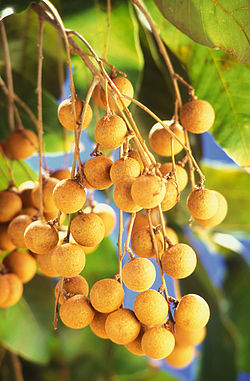Paul Thomson (botanist)
Paul Thomson | |
|---|---|
| Born | Paul H. Thomson June 29, 1916 |
| Died | May 31, 2008 (aged 91) Fallbrook, California, U.S. |
| Nationality | American |
| Scientific career | |
| Author abbrev. (botany) | P.H.Thomson |
Paul Thomson (June 29, 1916 – May 31, 2008) was an American
, and was an avid collector of the plants.Life
Early life
Paul Thomson was born on June 29, 1916, in India to parents, Clinton and Bertha Mangon Thomson.[1] His mother was a doctor who ran a local Indian hospital while his father was a minister.[1] Tragedy struck the family when Thomson was hunting with his father when he was 11 years old. His father had shot two ducks for the family's Christmas dinner, but drowned while trying to retrieve them from a lake.[1]
Thomson, his mother and his four younger sisters returned to the
Thomson enlisted in the
Death
Paul Thomson died on May 31, 2008, at the age of 91, of complications related to old age,[1] at a retirement home in Fallbrook, California.[2] He was survived by his four younger sisters, Margaret Greiber, Catharine Kingsolver, Alice Hasenyager, and Ellen Hanly. His wife, Helen, died in 2007.[2] They had been married for 65 years.[1]
Career
Rare fruits

Thomson began experimenting with rare fruits during the early 1950s after being stationed in San Diego. He and his wife, Helen, purchased five acres (2 ha) of land in
Thomson decided to make another attempt at growing tropical fruits with a second farm in a different location. In 1962, Thomson purchased another small farm in Vista, California, and called it Edgehill.[2] His newest farm and orchard was only five miles (8 km) from his other property in Bonsall, but it had a much milder climate, especially during the winter.[1] This made Edgehill more conducive to growing tropical, exotic fuits that had not been previously grown in California. He was able to finally grow successful harvests of mangoes, cherimoyas, lychees and other fruits.[2]
The Los Angeles Times reported in 1971 that Thomson was able to grow 96 separate types of fruit between his two orchards in Bonsall and Edgehill.[1] Most of these fruits had not been widely grown in the United States before Thomson planted them on his properties.[1] Thomson grew the first successful Mammee apple crop, also known as the South American apricot or the mamey, of note in California.[1] He also ran the only longan orchard in the United States at the time.[1] A friend of Thomson, Jim Neitzel, said that his Edgehill farm soon attracted the attention of other botanists and tropical fruit enthusiasts. "His Edgehill property was the biggest feather in his cap. People would come from all over the state to check it out."[2]
However, lack of demand for Thomson's fruits in the marketplace at the time forced him to close the Edgehill property in 1972.[2] In a 1989 interview with the San Diego Union-Tribune Thomson told the newspaper that, "I was 20 years ahead of my time...I never made enough to pay the water bill, let alone make any money."[1]
Thomson, an
California Rare Fruit Growers Association
Thomson and John Riley, a
The association rapidly grew in California during the late 1960s, in part because many newcomers were moving to the state "without prejudice to what could not be grown" in California.
Work on Dudleya
Thomson became interested in the Crassulaceae succulents of the genus Dudleya at some point in his life. Dudleya closely resemble the more commonly cultivated Echeverias. Early publications actually listed the Dudleya under either the Echeveria or Cotyledon genera. This genus is primarily native to chaparral habitats in California and Baja California state (Mexico), and consists of approximately 60 named species.
Limited literature and a passion to learn more on the plants that had piqued his interest, Thomson set forth on gathering specimens, assembling species descriptions, drawing habitat location maps and taking photographs which all culminated in him privately publishing the Dudleya and Hassenthaus Handbook in 1993. Of note are his SEM photographs of the flowers. It is one of the few books dedicated to the genus and contains numerous photographs of specimens in the wild and his own collection.[5] However, Thomson failed to follow the International Code of Botanical Nomenclature in place at the time, which invalidated most of his new treatments of species. Despite this, some of the plants Thomson first suggested as distinct were later described properly by other botanists, one example being Dudleya gnoma by Stephen Ward McCabe, which was originally placed as Dudleya nana by Thomson.[6]
Thomson shared his plants freely and supporters provided specimens from their respective collecting trips. Thomson also shared his insights into their hybridization with avid enthusiasts and his findings were later confirmed as naturally occurring, as he had suspected. Most of his collection was lost during a severe freeze. His contributions to the knowledge of the genus Dudleya is overshadowed by his work on the rare fruits.
See also
References
- ^ a b c d e f g h i j k l m n o p q r s t u v w x y z aa ab ac Nelson, Valerie J. (2008-06-16). "Paul Thomson – California grower of exotic tropical fruits". Los Angeles Times. Retrieved 2008-08-02.
- ^ San Diego Union-Tribune. Retrieved 2008-08-02.
- ^ Nelson, Valerie J. (2008-06-15). "Paul Thomson, 91; botanist was first to plant many exotic fruits in U.S." Los Angeles Times. Retrieved 2008-08-07.
- California Rare Fruit Growers. Retrieved 2008-08-02.
- ISBN 978-0960206650.
- ^ Stephen Ward, McCabe (1997). "Dudleya gnoma (Crassulaceae): A new species from Santa Rosa Island". Madroño. 44: 48–58 – via JSTOR.
- ^ International Plant Names Index. P.H.Thomson.
